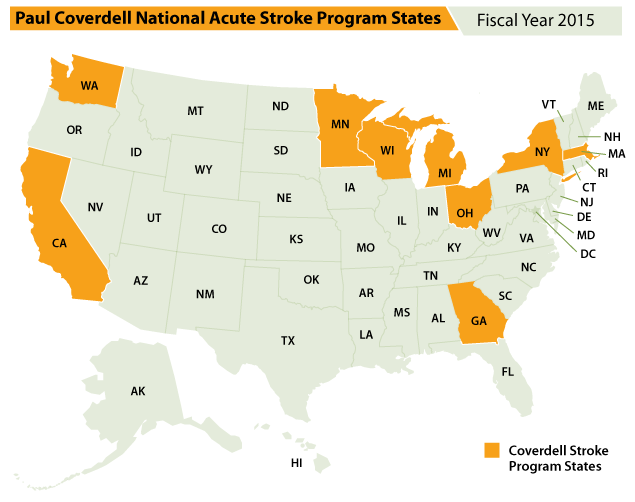PCNASP Currently Funded States
The Paul Coverdell National Acute Stroke Program currently funds nine states: California, Georgia, Massachusetts, Michigan, Minnesota, New York, Ohio, Washington, and Wisconsin.

Learn More
Learn more about each of the states currently funded by Coverdell:
Success Stories
Read success stories from current funded states:
- Educating First Responders to Improve Stroke Care: Georgia Stroke Registry [PDF-142K]
- Improving Stroke Care in Nursing Homes: Massachusetts Stroke Registry [PDF-132K]
- Coverdell Success Story: Beloit Memorial Hospital [PDF-1M]
- Coverdell Success Story: Theda Clark Medical Center [PDF-178K]
- Coverdell Success Story: ProHealth Care [PDF-697K]
- Community Education that Works: Moundview Memorial Sees Success in Stroke Outreach [PDF-172K]
Dr. Michael Frankel’s Story: Understanding the Components of Better Care for Stroke Patients
Published April 26, 2016
As the lead neurologist for the Coverdell Stroke Program in Georgia, Dr. Michael Frankel engages hospitals to participate in Georgia’s stroke registry. Participating hospitals better connect the continuum of care so that physicians have more information to make the right decisions every time. The data show that stroke death rates are lower in the communities served by hospitals that embrace practices supported by Coverdell.
Why Should I Partner with the Coverdell Program?
Hospitals, health care systems, EMS agencies, and communities that partner with Coverdell benefit through:
- Improved stroke care for your patients that saves lives and prevents disability.
- Online and in-person training and resources to support your coordination with EMS and increase availability and accuracy of EMS data.
- Sharing of data and best practices between EMS agencies and hospitals.
- Assistance with data analysis and comparisons on the regional, state, and national levels.
- Improved performance on state and national stroke measures such as door-to-needle time and defect-free care.
- Reduced readmissions for stroke by focusing on post-acute transitions and secondary prevention with community partners.
- Access to training and a network of healthcare providers all motivated to improve stroke care and willing to share lessons learned.
- Recognition by state and national government and associations involved in stroke improvement.
See what grantees are doing across the nation:
- The Ohio and Wisconsin Coverdell programs created radio ads to spread the message about the importance of recognizing the signs of stroke and acting F.A.S.T. In May 2016, Wisconsin ran the ads which played in over 77 stations across the state with a reach of 847,700 and more than 2.7 million impressions. Stay tuned for the Ohio ads, which were used as a model for the Wisconsin ads!
- New York’s Coverdell program conducted a F.A.S.T. campaign from April to June 2016 in the Rochester area. The campaign included TV and social media ads. Estimated reach of the TV ads was 85% of the target audience (adults 35 and older), with a total of 477 spots. Social media engagement was approximately 33,000.
- Page last reviewed: May 18, 2017
- Page last updated: May 18, 2017
- Content source:



 ShareCompartir
ShareCompartir